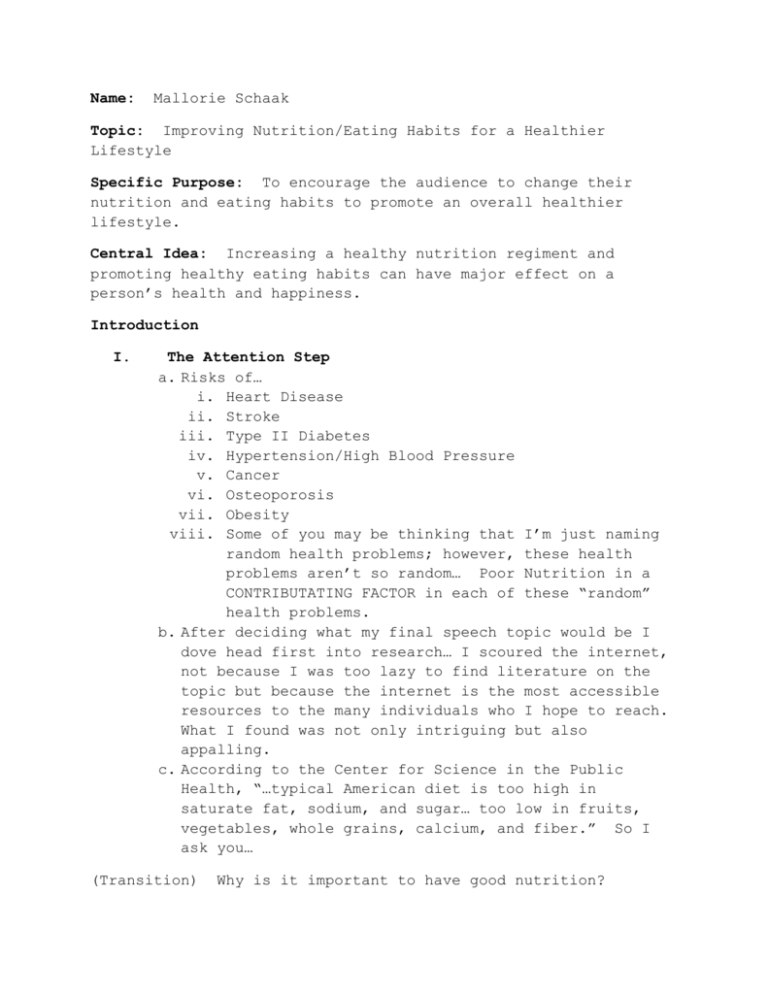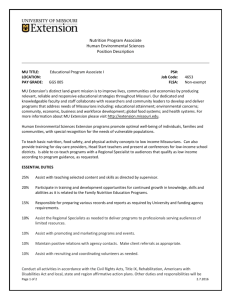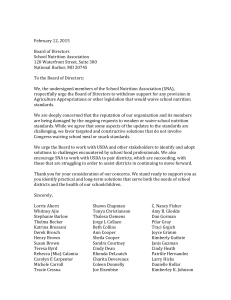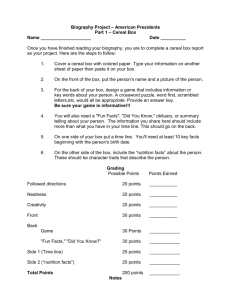Monroe`s Motivated Sequence Outline – Schaak
advertisement

Name: Mallorie Schaak Topic: Improving Nutrition/Eating Habits for a Healthier Lifestyle Specific Purpose: To encourage the audience to change their nutrition and eating habits to promote an overall healthier lifestyle. Central Idea: Increasing a healthy nutrition regiment and promoting healthy eating habits can have major effect on a person’s health and happiness. Introduction I. The Attention Step a. Risks of… i. Heart Disease ii. Stroke iii. Type II Diabetes iv. Hypertension/High Blood Pressure v. Cancer vi. Osteoporosis vii. Obesity viii. Some of you may be thinking that I’m just naming random health problems; however, these health problems aren’t so random… Poor Nutrition in a CONTRIBUTATING FACTOR in each of these “random” health problems. b. After deciding what my final speech topic would be I dove head first into research… I scoured the internet, not because I was too lazy to find literature on the topic but because the internet is the most accessible resources to the many individuals who I hope to reach. What I found was not only intriguing but also appalling. c. According to the Center for Science in the Public Health, “…typical American diet is too high in saturate fat, sodium, and sugar… too low in fruits, vegetables, whole grains, calcium, and fiber.” So I ask you… (Transition) Why is it important to have good nutrition? Body II. The Need Step. Of the 7 chronic conditions, I named at the beginning of my speech, 4 make the list of top 6 leading causes of death… 2011 Statistics a. Heart Disease deaths 596,577; causes of heart disease *Atherosclerosis which is caused by CORRECTABLE problems such as “unhealthy diet, lack of exercise, being overweight, and smoking.” *Heart arrhythmia – (abnormal heart rhythms) among causes are high blood pressure and diabetes b. Cancer deaths 576,691; (National Cancer Institute) *Obesity: increases risk of cancers associated with -Esophagus, pancreas, colon/rectum, breast (after menopause), endometrium (lining of the uterus), kidney, thyroid, and gallbladder. -2007-2008 National Health and Nutrition Examination Survey showed that 68% of U.S. adults 20 or older are overweight or obese and 17% teen/children. - Percentage of cases attributed to obesity varies but can be as high as 40% for some cancers. c. Stroke deaths 128,932; occurs when an artery to the brain becomes blocked or ruptures as a result blood flow is cut off to parts of the brain depriving oxygen and glucose causing the brain to die. Also known as brain attack. *Controllable Risk Factors include many conditions caused by poor nutrition. Those include: -High blood pressure -Heart Disease -High cholesterol -Diabetes -Overweight or obesity d. Diabetes deaths 73,831; Risk factors… -High blood pressure -High blood fat levels -High fat and carbohydrate diet -Obesity or being overweight (Internal summary: You may be telling yourself… These seem like the most extreme outcomes of having a cheeseburger and fries instead of a salad and water… But what I’m relaying to you is that you don’t want wait until you are at this point to decide that you need to make a change.) (Transition) Making a change in your nutrition is making a decision to better your body for the future. III. The Satisfaction Step. a. The benefits of having a proper nutrition are numerous… i. According to the World Health Organization a balanced diet… 1. Boosts immunity and healthy development; 2. Protects against certain types of diseases… a. In particular the noncommunicable disease we previously discussed; 3. Contributes to a healthy body weight; and 4. Is an important step towards a happy and healthy lifestyle. b. Improved nutrition not only has an effect on your physical health but also your mental health. i. Brain Food: 1. Protein: used for growth and repair around the body; chemical messengers used to transport information to other parts of brain, i.e. signals about mood. 2. Fats: Nerve cells in brain made up of fat; body and brain run on glucose (Internal Summary: The numerous benefits of proper nutrition overweigh the devastating consequences of poor nutrition.) (Transition) Now that you know some of the benefits and consequences of nutrition let me tell you how to improve your current nutrition to provide a better present and future for you and your body. IV. The Visualization Step. Pamela Hinton’s, Ph.D., article title “Improving Your Nutrition in Four Simple Steps,” provides a great start to what will be a lifestyle change for the better. a. Step 1. Achieve a healthy body weight i. Hinton agrees that although this “sounds daunting” just a couple small steps maintained over time will do the trick: 1. Substitute water for sugary soda/fruit drinks 2. Ask for your latte with skim milk and no whip 3. Revamp your snacks from “chips, crackers, cookies or candy” to “fresh-fruit, baby carrots, air-popped popcorn, etc” b. Step 2: Reduce your intake of saturated fat, trans fat, sugar and sodium i. When consumed in excess these contribute to weight gain and chronic disease 1. Limit intake of processed grains and snacks; choose dried fruits, pretzels or nuts instead. 2. Limit intake of processed meats (bacon, lunch meat and sausage) and of cheese and pizza; instead prepare lean cuts of fresh meet and choose low-fat cheese; try mixing in beans or tofu as a source of protein. 3. Use less salt; instead enhance flavor with herbs and spices 4. If you are unsure check the label of foods that you are planning to eat; avoid products with added sugars (sucrose, glucose, highfructose corn syrup) or trans-fat. c. Step 3: Increase intake of fruits, vegetables, whole grains, fish and diary. i. They contain multitude of vitamins and minerals. 1. Eat more fruits and vegetables at meal time and for a snack. 2. Swap whole grains for processed. I.e. choose brown rice and whole wheat pasta. 3. Choose fat-free or low-fat milk, yogurt and cottage cheese. 4. At least 2 times a week choose seafood rather than meat to increase intake of omega-3 fatty acids. d. Step 4: Be a conscientious consumer when eating out! i. Ask for salad dressing, butter, sour cream on the side to give you control of the amount used. ii. Avoided dished prepared with cream/served with cream sauce iii. Choose steamed, broiled or baked over fried or sautéed iv. Don’t be afraid to ask for a “take-home” container v. Don’t forget dessert…choose a fruit sorbet, pie, or share with a friend e. These steps are not an all-encompassing guide on how to improve your nutrition. These steps are a jump start in the right direction. There are numerous resources available to help you on your path to a healthy nutrition. f. ChooseMyPlate.gov: Provides nutrition education materials for consumers (you and I) and for professionals. Examples: Daily Food Plans and Sample Menus. g. Helpguide.org: Provides tips for planning and sticking to a healthy diet. In depth look into each food group and provides help steps to set you up for success. (Transition) I urge you; take the steps toward a healthier future… Protect yourself from the disastrous consequences of a diet poor in nutrition. Conclusion V. The Action Step. a. (Summary) Hundreds of thousands for people die every year from health conditions that have poor nutrition as a major contributing factor. b. (Call to Immediate Action) It is up to you to protect yourself from these health conditions. Take steps now to reduce risks and control the factors that lead to many of these deaths. Grab a apple on the way out the door instead of that donut, eat grapes while at your desk instead of that bag of M&M’s, and drink water instead of you daily soda… Every step in the right direction is the right step! c. (Memorable Close) Only you can make the decision to create a healthier lifestyle for yourself. Only you can take the steps to make a change. Only you can push yourself to be a better you. So I urge you; for no one other than yourself… Take that first step and then continue down a path of healthier choices and a healthier life! References "Benefits of a Balanced Diet." WHO/Europe |. Web. 24 Nov. 2014. <http://www.euro.who.int/en/health-topics/diseaseprevention/nutrition/a-healthy-lifestyle/benefits-of-abalanced-diet>. "Daily Food Plans & Worksheets." Daily Food Plans &amp; Worksheets. Web. 24 Nov. 2014. <http://www.choosemyplate.gov/supertracker-tools/dailyfood-plans.html>. "Healthy Eating." : Easy Tips for Planning a Healthy Diet and Sticking to It. Web. 24 Nov. 2014. <http://www.helpguide.org/articles/healthy-eating/healthyeating.htm>. Hinton, Pamela. "ACSM | Articles." ACSM | Articles. 2 Feb. 2012. Web. 24 Nov. 2014. <http://www.acsm.org/access-publicinformation/articles/2012/02/02/improving-your-nutritionin-four-simple-steps>. "Leading Causes of Death." Centers for Disease Control and Prevention. Centers for Disease Control and Prevention, 14 July 2014. Web. 24 Nov. 2014. <http://www.cdc.gov/nchs/fastats/leading-causes-ofdeath.htm>. "Mental Health." Nutrition for Mental Health Issues. Web. 24 Nov. 2014. <http://www.nutritionistresource.org.uk/articles/mental-health.html>. "Obesity and Cancer Risk." National Cancer Institute. Web. 24 Nov. 2014. <http://www.cancer.gov/cancertopics/factsheet/Risk/obesity> "Recipes." Sample Menus and. Web. 24 Nov. 2014. <http://www.choosemyplate.gov/healthy-eating-tips/samplemenus-recipes.html>. "Stroke: Causes and Risk Factors." WebMD. WebMD. Web. 24 Nov. 2014. <http://www.webmd.com/heart/atrial-fibrillationstroke-11/stroke-causes-risks>. "Type 2 Diabetes Causes and Risk Factors." WebMD. WebMD. Web. 24 Nov. 2014. <http://www.webmd.com/diabetes/guide/diabetescauses>. "WHY POLICY." Why Good Nutrition Is Important. Web. 24 Nov. 2014. <http://www.cspinet.org/nutritionpolicy/nutrition_policy.ht ml>.







